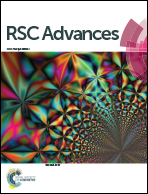Economically viable sensitive and selective luminescent sensor for the determination of Au(iii) in environmental samples†
Abstract
This paper describes the ultrasensitive and selective determination of Au(III) in an aqueous solution using a functionalized mercapto thiadiazole ligand. UV-visible and spectrofluorimetry studies of functionalized mercapto thiadiazole ligands such as 2,5-dimercapto-1,3,4-thiadiazole (DMT), 2-amino-5-mercapto-1,3,4-thiadiazole (AMT) and 2-mercapto-5-methyl-1,3,4-thiadiazole (MMT) were carried out in the presence of Au(III) ions in solution. DMT, AMT and MMT exhibit an absorption maximum at 330, 310 and 299 nm, respectively. The emission intensities of the respective compounds were enhanced at 435, 428 and 442 nm after the addition of 1 nM Au(III); furthermore, the color of the solutions also changed to yellow. The observed color changes and emission intensity enhancement are ascribed to the effective complex formation of Au(III) with DMT, AMT and MMT ligands. When 8 nM Au(III) was added into the aqueous solutions of DMT, AMT and MMT, the emission intensity was enhanced to 102, 8 and 5-fold, respectively. The binding constants for DMT, AMT and MMT–Au(III) complexes were found to be 1.52, 1.05 and 1.04 × 105 mol−1 L, respectively. The higher emission intensity and binding constant value obtained for DMT reveals that the DMT–Au(III) complex is highly fluorescent compared to the other two complexes. Thus, DMT was chosen as a fluorophore for the determination of Au(III). Interestingly, even after the addition of 1 pM Au(III) into DMT solution, the emission intensity was enhanced at 435 nm. Based on the enhancement of emission intensity, we have determined the concentration of Au(III) and the detection limit was found to be 1 pg L−1 (S/N = 3). Furthermore, 60 000-fold higher concentrations of common interferences and 500-fold higher concentration of Cu(II), Pb(II), Ag(I), Ag(II) and Ag(III) did not interfere for the determination of 8 nM Au(III). The proposed method was successfully applied to determine Au(III) in different water samples and the obtained results were validated with ICP-AES. The present method of determination has several advantages, including low cost and environmental friendly nature.


 Please wait while we load your content...
Please wait while we load your content...